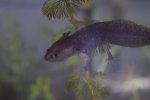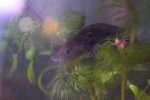Grismel
New member
- Joined
- Jan 11, 2016
- Messages
- 16
- Reaction score
- 0
- Points
- 1
- Location
- Connecticut
- Country
- United States
Hi everyone.
Im a new axie owner and ive been experiencing a problem with one of my axies. when i first obtained little pika he was energetic and would snap at anything that i would feed him. however over the past week or so he has been refusing to eat anything even when i try to entice him by dangling it in front of him. since its already been so long after he ate im starting to worry that hes going to starve himself to death. he is also a bit paler but that may be due to the fact i keep him in white sand (hes a black melanoid) Another problem which i believe to be the cause of the not eating is that his once beautiful gills have drastically receded almost as if he had curled it back. there are no real filaments on the stalks that i can see, and it seems that he is only relying on his lungs for oxygen as the frequently goes to the top for a gulp. I have tried fridging him for a day to see if he was constipated or maybe he had eaten too big a piece of a worm, but that was not the case as he had nothing unusual in his bowels. I did a water test after 3 days of him not eating and the only abnormality is that my PH had a drastic drop down to a 6. I believe this was due to the introduction on many plants in the tank but i could be wrong. i also had to do a large water change of about 50% so maybe its shock?(the water was dechlorinated BTW) Since then i have raised the PH to 7.3 by using baking soda. Any help on the matter will be greatly appreciated, thank you for taking the time.
Water parameters
PH 7.3
ammonia 0.0
nitrate 0.0
nitrite 0.0
temp 60-75 degrees F
Food
frozen bloodworms
chopped up earthworms
axolotl pellets (found on the forum)
Im a new axie owner and ive been experiencing a problem with one of my axies. when i first obtained little pika he was energetic and would snap at anything that i would feed him. however over the past week or so he has been refusing to eat anything even when i try to entice him by dangling it in front of him. since its already been so long after he ate im starting to worry that hes going to starve himself to death. he is also a bit paler but that may be due to the fact i keep him in white sand (hes a black melanoid) Another problem which i believe to be the cause of the not eating is that his once beautiful gills have drastically receded almost as if he had curled it back. there are no real filaments on the stalks that i can see, and it seems that he is only relying on his lungs for oxygen as the frequently goes to the top for a gulp. I have tried fridging him for a day to see if he was constipated or maybe he had eaten too big a piece of a worm, but that was not the case as he had nothing unusual in his bowels. I did a water test after 3 days of him not eating and the only abnormality is that my PH had a drastic drop down to a 6. I believe this was due to the introduction on many plants in the tank but i could be wrong. i also had to do a large water change of about 50% so maybe its shock?(the water was dechlorinated BTW) Since then i have raised the PH to 7.3 by using baking soda. Any help on the matter will be greatly appreciated, thank you for taking the time.
Water parameters
PH 7.3
ammonia 0.0
nitrate 0.0
nitrite 0.0
temp 60-75 degrees F
Food
frozen bloodworms
chopped up earthworms
axolotl pellets (found on the forum)
Last edited:






